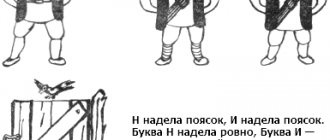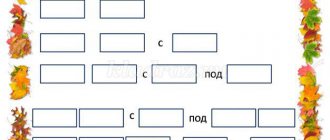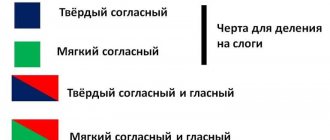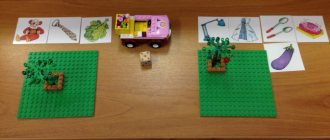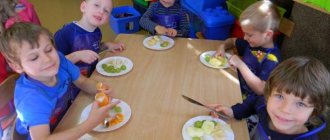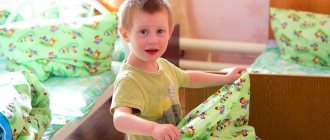Card index of didactic games for teaching literacy.
Irina MALINOVSKAYA
Card index of didactic games for teaching literacy.
The curriculum of preschool education determines the content of work with preschoolers in the educational area “ Teaching literacy ”
in the older group.
The program defines the goal of the work: the formation of initial linguistic ideas, nurturing interest in language and speech as phenomena of reality.
In the process of working with older preschoolers, we form children’s ideas about words, about the structure of words, teach them to divide words into syllables, conduct a sound analysis of words, and compose sentences with a given number of words.
The content of activities with children is defined in the sections “The word, its meaning”
,
“Verbal analysis of a sentence”
,
“Syllable analysis of a word”
,
“Sound analysis of a word”
.
literacy games that will help you organize the educational process in accordance with the requirements of the program .
"Who? What?"
- systematize knowledge about living and inanimate objects of nature, practice asking questions to words denoting objects.
The teacher shows the children pictures depicting natural objects (butterfly, birch, stone, etc.)
.Children pose questions to them: if the object is alive, they ask
“Who is it?”
, and if the object is inanimate -
“What is this?”
For the correct answer - a chip.
"Word or Sound"
- systematize knowledge about the concepts of
“word, sound”
.
The teacher says: “tree, m, sky...”
Children should think about what was said: if there is a sound, keep silent, if there is a word, clap your hands. The one who makes no mistakes wins.
“How many words did you hear?”
- develop auditory perception and memory.
The teacher or presenter pronounces the words in order. Children must determine the number of words and, if possible, repeat as many as they remember.
"Guess the word"
- develop the ability to use a word to designate an object based on its description.
The teacher thinks of a word. For example: a person who is guarding something. Children guess - watchman. For the correct answer - a chip.
"Record player"
- consolidate ideas about the sounding word.
Children, under the guidance of a teacher, examine the tape recorder and talk about its purpose. The teacher says a word in everyone's ear, and the children take turns pronouncing the words loudly, the word is recorded on a tape recorder. Children listen to the recording.
"Name the action"
- form ideas about words and actions.
The child performs actions as instructed by the teacher (draw, clap)
and names them.
The teacher says that these are words denoting actions and asks “What else can you do?”
. Children call words - actions. For the correct answer - a chip.
"Pick a Pair"
- exercise the ability to select a word denoting an action, a pair, a word denoting that the action is completed
(read - read)
.
You can play with a ball.
"Which? Which? Which?"
- form ideas about words denoting the characteristics of an object.
The teacher shows a picture (for example, a tomato, a hat, a table, a bucket, etc.), and the children answer the question “Which tomato?”
.
"Answer quickly"
- practice identifying an object by its characteristics.
The teacher names the signs (white-trunked, slender, tall, children guess the object, the teacher puts up a picture .
"One word - many objects"
- form ideas about the polysemy of words.
The teacher shows an object (fountain pen)
and asks
“What is this?”
, takes the doll by the hand - What is this?
(pen)
.
What's at the door? (pen)
.
What other objects have a handle? (suitcase, bag)
. Result: there are many objects, but one word. Similar work is carried out with the words: chanterelles, braid, tile.
"Long - short word"
- practice selecting and distinguishing between long and short words.
"Say kindly"
- form the concept of the diminutive form of the word (hedgehog - hedgehog, exercise in the formation of words with a diminutive meaning.
“Name two (three)
words" - practice naming a given number of words.
“Choose a similar word”
- practice selecting consonant words and rhymes.
The teacher suggests listening to the words “Cat – spoon – leg”
.
How are the words similar? He tells the children “Now you will turn into poets and select a consonant word - a rhyme for a given word (books, ears, birds, hedgehogs, etc.)
.
"Who went ahead"
- practice differentiating between long and short words.
Children say the words in order and step forward. Whoever went further has the longest word.
“Words are relatives”
- form ideas about related words.
The teacher invites the children to look at a story picture about winter (spring, summer, etc.)
.Questions for children: What can you call winter?
What do you call a day in winter? What do we call the birds that stay with us in winter? What is a “winter hut”
?
we named winter words. Which? Children repeat winter words. In them we hear the general part of “winters”
.
These are all words - relatives, because they are all similar to the word "winter"
.
Children select words - “relatives”
to the words - tea, mushroom, sea, forest, water, leaf, etc.
"Make a proposal"
- form the concept of
“sentence”
, practice making sentences based on a plot
picture , according to a diagram.
"Guess the Sound"
- form the concept of
“sound”
.
Children with their eyes closed guess what sounds (the tapping of a pencil on the table, the murmur of water in a glass, etc.)
.
The teacher asks “What did you hear?
How did you guess?” .
"Words are friends"
- form ideas about synonyms
(words that sound different but have the same meaning)
.
“big” in another way?
?
(huge)
Fast?
(fast)
, etc.
"Sing the Sound"
- form the concept of
“vowel sound”
,
“consonant sound”
.
Children are asked to sing the sounds - a o y and y e g k x. The teacher asks the question “What happened? What sounds did you sing? Which ones are not? Why?"
sounds that can be sung are called
"vowels"
. Those sounds that cannot be sung are consonants.
"Vice versa"
- form ideas about words - antonyms
(words with opposite meanings)
.
Ball game. Children stand in a circle. The teacher pronounces the word “black”
, throws a ball to the child, he must say the word backwards.
“Name a sound or word”
- consolidate the concepts of
“sound”
,
“word”
.
The teacher gives the child a task: name any sound, name a word, 2 words, 3 any sounds, etc.
“Who lives in the house?”
- form an idea of the sound composition of a word.
The teacher says: “In the house I lived, there was the sound U, and next to it in another house there was the sound A. One day, U’s house fell apart, and A invited U to come to him. They began to live together AU. What's the first sound? Second? What word did you get? Children are reading. What if U and M live nearby? M A, etc.
“How many sounds?”
- practice sound analysis of words, determining the order of sounds
(first, second, etc.)
.
"Choose a word"
- practice selecting words for a given sound.
For the correct answer - a chip.
"Magic Echo"
- practice identifying the first sound in a word.
The teacher says that Echo has settled in the group. Children find out what an echo is. The teacher says that it is unusual and pronounces only the first sound of the word.
"Guess yourself"
— to develop sound analysis skills, determining the first and last sound in a word.
Children look at objects, name words, highlighting the first and last sound. The word is indicated by a chip. If the answer is correct, the word goes into the basket, if the answer is incorrect, it goes into the bucket.
"Come up with a proposal"
- consolidate the concepts of
“word”
and
“sentence”
, practice the ability to expand with a sentence.
Children make up sentences based on the plot picture and diagram . The teacher asks questions: How many words are in the sentence? What's the first word? Second? etc.
“Where are the little animals hiding?”
- develop sound analysis skills.
The teacher says: “The animals decided to joke. They hid behind the pictures (they are on the board)
.
Guess which ones? The name of the animal and the name of the picture begin with the same sound (hare - umbrella, cubes - wild boar, beaver - drum, etc.)
.
“Choose the word according to its meaning”
- practice selecting words in a sentence according to their meaning, counting the number of words in a sentence.
The teacher begins the sentence, the children select the word according to its meaning: “We are building a new... (house)
" etc.
"Live Sounds"
- practice sound analysis of words.
Children are assigned sounds. They have chips of the corresponding color. At the teacher’s command, the children form a word. The rest "read"
this word. You can compete in teams.
"Suitcase"
- practice selecting words with a given sound, classifying objects.
The teacher has a suitcase. He says that he is going on a trip and will take with him things that have a sound in their names... Children help “collect”
suitcase.
The topics of words can be different (for example: clothes, shoes, household appliances, etc.)
.
"Sounds Get Lost"
- develop phonemic synthesis, practice composing words from sounds.
Children are given cards with sounds . The task is to assemble the sounds into a word.
"Compare the word"
- practice comparative sound analysis of words
(house - smoke, catfish - himself, com - cat, etc.)
.
“What word did you hear?”
- practice differentiating long and short words by ear.
"Chain of Words"
- practice selecting words that begin with a given sound.
The teacher offers to collect beads from words (based on pictures )
– arrange
the pictures so that the last sound in a word is the first sound in the next word. You will get beads (for example: ball - crayfish - cat - tank - doll - stork - tiger)
.
"Vowel - consonant"
- practice differentiating vowels and consonants.
The teacher names the sound, the children determine what it is and explain the choice.
"Count the syllables"
- form the concept of
“syllable”
, practice dividing words into syllables.
“Who lives in the hut?”
- practice classifying objects (animals, insects, etc., identifying words with a given sound.
The teacher shows the hut and says: “Insects live in the hut. The first to come to the hut was an insect whose name begins with the sound K, etc. How many residents are there in total?
"On the contrary"
- practice changing the order of sounds in a syllable.
The teacher is a sorceress. Uses a magic wand to turn children into “reverse”
and says
“Listen to the syllables and pronounce them backwards, swapping the sounds
.
For the correct answer - a chip (CA - AS, etc.)
.
"Separators"
- practice dividing words into syllables.
The Tin Woodman enters with a hatchet. The teacher asks “What is an ax for?”
.
The woodcutter says, “My ax is magical. He knows how to chop words into pieces. What are the parts of a word called? (syllables)
Take your
“hatchets”
in your hands (children put their fingers in
a “lock”
- this is
a “hatchet”
, they hit the table with it - divide the words into syllables). Children name the number of syllables in a given word, the first sound, the second, etc.
"Sound Lotto"
- practice identifying the first sound in words, dividing words into syllables.
Children have cards with 5 - 6 subject pictures , chips. The teacher shows colored symbols of sounds; children must use chips to cover those pictures whose names begin with the given sound. The winner is the one who covers the pictures . Then the teacher invites the children to take pictures from the card , name them and determine the number of syllables in the word.
"Magicians"
- exercise children in converting words.
The teacher invites the children to become magicians. “We will turn one word into another. To do this, you need to remove one sound from this word and name a new word (duck - dot, trouble - food, etc.)
.
"Find your place"
- practice determining the number of syllables in names.
The teacher invites those children whose names have 2 syllables to stand on their left, and those on their right - 3 syllables.
"Hammer"
- to form children’s ideas about stress in words, in determining the stressed syllable in a word.
The teacher pronounces words, highlighting the stressed syllable, then pronounces the word, placing the stress incorrectly. Discusses with children whether they recognized the word or not? Why? Then the children are given hammers and the children pronounce the words by hitting the stressed syllable with the hammer.
"Broken Microphone"
- develop auditory perception.
The teacher shows the children a microphone. What is a microphone for? Then the teacher says that this microphone is faulty and the sound disappears. Children must help fix the microphone. The teacher pronounces words into the microphone, skipping a syllable (SO ... KA, KO ... VA)
and shows
the picture .
The child pronounces the word loudly, finishing the missing syllable that was not amplified by the microphone. "Exhibition"
- practice determining the number of syllables in a word.
The teacher says that the children came to the exhibition. The exhibition exhibits are located on 3 stands. On the first stand are items whose names consist of one syllable, on the second - from 2 syllables, on the third - from 3 syllables. The child takes an object picture , names the object, determines the number of syllables and places the exhibit on a certain stand.
"Make a proposal"
- practice making sentences based on plot
pictures .
"Tasty words"
- practice determining the number of syllables in words, selecting words with a given number of syllables.
The teacher says that today is Katya’s doll’s birthday. We will help her choose a treat. The names of all treats must consist of 2 (3)
syllables.
"Choose a gift"
- practice selecting words with a given sound, determining the position of the sound in a word.
The game is based on object pictures . Children and their teacher are going to Carlson's birthday party. The teacher says that it is customary to give gifts on birthdays. The guys select gifts for a specific sound. For the correct answer - a chip.
Card index of didactic games to prepare children for learning to read and write
2nd option:
knife (nose), son (dream), ice (honey), daughter (barrel), fireworks (salad).
3rd task.
All the vowels have disappeared from the word. Try to guess what these words are by placing the vowels correctly:
1st option:
sh_k_l_d (chocolate), k_r_n_d_sh (pencil);
2nd option:
p_t_l_k (ceiling), t_l_v_z_r (TV).
4th task.
Make up words from the first syllables of the given words:
1st option:
city - spoon - jam (head), chieftain - chicken - lava (shark);
2nd option:
sun - loaf - pencil (dog), box - elbow - sausage (bell).
For each correctly processed word in each task, the team is given a bonus point. An additional 2 points are awarded to the team that completes the task first.
5
"Red and Blue Balls"
Target
: develop literacy, consolidate the differentiation of vowels and consonants, improve attention, reaction, dexterity, speed of thinking.
Children stand in a circle. An adult stands in the middle, throws a red or blue ball to the participants in the game and pronounces any sound. The child must catch the red ball if he hears a vowel sound, and not catch it if he hears a consonant sound. If the ball is blue, everything should be the other way around. Then the child himself throws the ball and makes the sound.
The balls can be used in the game alternately or simultaneously. An adult stands in the middle and catches the fallen balls, putting them back into play.
6
"Typewriter"
Target
: develop phonemic awareness skills, sound-letter analysis, attention.
Description:
Each child is assigned a specific letter of the alphabet. The adult offers to “type” some long word or phrase. In the latter case, you can give one of the kids the task of marking the “space” between the words in it. Then, at a signal from an adult, the participants in the game begin to “type”: first, the first letter is clapped once, then the second, etc. When everything is “printed,” all participants in the game clap. Start the game with simple words, gradually introducing more and more complex ones.
7
"The Cow and the Word"
Target
: develop phonemic hearing, reaction.
Description:
Children sit on chairs in a circle so that the child’s right hand lies palm down on the palm of the left hand of the neighbor on the right, and the left hand is located under the right palm of the neighbor on the left. The game goes clockwise. The first player pronounces one word of the poem, simultaneously clapping his right palm on the hand of the neighbor on the right, then he pronounces the next word, clapping the neighbor’s palm, etc. The poem is as follows: “A cow flew and said a word. What word did the cow say?” The child on whom the poem stops must say any word, for example, “wall.” Now the players clap, spelling out the word they hear: “s-t-e-n-a.” The task of the last player is to have time to remove his hand so that it is not slapped on the last sound - in this case, “a”. Whoever is lazy is out of the game.
